Navigate this page
| Scotch Irish | Scotland/Clans | Londonderry Siege | Isle of Lewis |
|---|---|---|---|
| Mayflower | English Royalty | Norse Origins | Hold Space |
The Scotch Irish
It is a fact that the Morrisons who emigrated to the US in the 1700's were for the most part Scotch Irish. Certainly, Robert Morrison was. The Scotch Irish were Scotsmen through and through. But before coming to the US, their home had been in Northern Ireland. Their story in the 1600's tell a grim tale of persecution for religious beliefs, and mistreatment by various English kings. The Scotch Irish refer to emigrants who came from Scotland through Ireland to the US. They have no blood lines back to those of Irish descent.
For a complete history lesson, visit this site and read about the Scotch Irish written by James Leyburn, who wrote "The Scotch Irish, A Social History".
Scotch Irish Emigration to America
Below find an excellent history of the Scots Irish, found on Ulster Ancestry Website
The Scots-Irish: The Thirteenth TribeThanks to Raymond Campbell Paterson
"A man with God is always in the majority"
John Knox
"I love Highlanders, and I love Lowlanders, but when I come to that branch of our race that has been grafted on to the Ulster stem I take off my hat in veneration and awe" Lord Rosebery
Let us begin by asking a simple question-who are the Scots-Irish? Simple questions very rarely have simple answers, and the answer to this one is more complex than most. Much depends, moreover, on where in the world it is posed. In Britain the term is virtually unknown, and most people would assume that it meant some kind of hybridisation between the Irish and the Scots. Only the Protestant communities of Northern Ireland would generally recognise what is meant, though very few would now accept the designation for themselves, preferring to be described as British or Ulstermen. Only in North America, where the term was invented, would one be likely to encounter an immediate recognition; but even here there are problems. Many of the descendents of the original Scots-Irish settlers would happily wear kilts and tartan on commemorative days, though this would have been a shock to their ancestors, who took particular trouble to distance themselves from all things Celtic and Gaelic. The task of this article is to attempt what is always a dangerous endeavour: the separation of myth and reality, and thus uncover the roots of one of the most remarkable branches of the Scottish-and Irish-race.
The story begins with an ending. In March 1603, the same month that James VI of Scotland began James I of England and Ireland, the earls of Tyrone and Tyrconnell, chiefs of the O’Neills and the O’Donnells, the leading families of the ancient province of Ulster, surrender to the English. Thus concluded the Nine Years War, the latest in a long line of struggles to arrest the steady expansion of English power in Ireland. It was in Ulster that Celtic Ireland had made its last stand against a foreign invader, all the more unwelcome because he now came garbed in a cloak of militant Protestantism, a direct challenge to an ancient Catholic tradition. It had been a particularly bitter struggle, and Ulster had been devastated. The northeastern counties of Antrim and Down, within sight of the coast of Scotland, are described by contemporary writers as ‘all waste’.
For James the conclusion of the Nine Years War came as a welcome addition to his new glories; it also presented him with a problem and an opportunity. As a man and a king he was no more sympathetic to Gaelic traditions and culture than his Tudor predecessors on the English throne. While still King of Scots he had been preoccupied with the problems posed by his own minorities in the Highlands and Islands, whom he once described as ‘utterly barbarous.’ In the 1590s he had even sponsored a scheme of internal colonisation or plantation, handing over the island of Lewis to a party of Lowland adventurers. These men were to bring civilisation and commerce to the western Isles, in a project that allowed for the wholesale extermination of the local Gaelic clans. Faced with the widespread hostility of the Highland communities, the Lewis plantation was a costly failure: the idea, however, remained fixed in the royal mind.
In Ulster, unlike the Scottish Highlands, the local people had been severely demoralised. Plantation was not a new idea in Ireland, but past schemes had achieved very little. To begin with James showed little interest in a fresh project but for a series of unusual opportunities. The first involved two rather shady Lowland opportunists, the kind of men all too attractive to the enterprising king. James Hamilton was a university don and a spy; and Sir Hugh Montgomery, his partner, was an Ayrshire laird. Together they helped Conn O’Neill, an Irish chieftain, escape from Carrickfergus Castle, where he had been imprisoned for rioting, and offered to obtain a royal pardon for him in return for a share of his substantial estates in Antrim and Down. James, originally hostile to the proposal, became the fourth partner in the enterprise, no doubt amused by the audacity of Hamilton and Montgomery. Both men proposed to bring over large parties of Scots Lowlanders to replenish the depopulated areas, thus reviving the hitherto discredited idea of plantation. James now had a way of driving a Lowland, Protestant and English-speaking wedge into the heart of a Gaelic and Catholic world. In granting Hamilton the territory of Upper Clandeboy and Great Ardes, James emphasised the intention "…of inhabiting the same, being now depopulated and wasted, with English and Scottish men; and the carrying of men, cattle, corn and all other commodities from England and Scotland into the said territories. Also, to have liberty to alien [grant] to any English or Scottish men, or of English and Scottish name and blood, and not to have the mere Irish."
Ireland was formally an English possession, so it was important to emphasise English as well as Scottish settlement, though for reasons of geography and temperament, the new plantation was almost exclusively Scottish, as James himself clearly recognised it would be: ‘The Scots are a middle temper, between the English tender breeding and the Irish rude breeding and are a great deal more likely to adventure to plant Ulster than the English.’
Taking the lead of Montgomery and Hamilton, land hungry Scots crossed the North Channel in ever increasing numbers. What they found would have daunted all but the hardiest spirits: ‘…parishes were now more wasted than America (when the Spanish landed there)…for in all those three parishes [Glenabbey, Donaghadee and Newtonards] thirty cabins could not be found, nor any stone walls, but ruined roofless churches, and a few vaults at Grey Abbey, and a stump of an old castle in Newton, in each of which some gentlemen sheltered themselves at their first coming over.’ But the land was good and largely unfarmed, as the native Irish economy had been pastoral rather than arable. Settlers were also encouraged by the promise of long leases, far better than the unfavourable terms in their native Scotland, where short leases acted as a disincentive to good husbandry and improvements. Plantation, the Scots were soon to show, could be made to work, especially when it was supported by adequate military force.
A second and more significant opportunity came in September 1607. Although Hugh O’Neil, Earl of Tyrone, and Hugh O’Donnell, Earl of Tyrconnel, had made their peace with the government some years before, they had been subject to almost continual harassment by the Dublin authorities. Fearing for their safety, the two chiefs left for the continent, never to return, an episode famous in Irish history as ‘The Flight of the Earls.’ James now had huge territories in central and western Ulster: Hamilton and Montgomery’s free enterprise scheme was supplemented by the Plantation of Ulster. Land was granted to men known as ‘undertakers’, who pledged themselves to bring over settlers from England and Scotland; only the more inferior lands were to be allotted to the native Irish. This time more English settlers began to make an appearance, though they continued to be numerically weaker than their Scottish cousins. This is hardly surprising: England was richer and far more settled than Scotland, and Ireland remained a dangerous frontier. Native Irish chieftains, deeply resentful of their changing circumstances, took to the wilds as outlaws, and as ‘woodkernes’ represented a real threat to the more isolated settlers, many of whom were wiped out in midnight raids. The descendants of the Scots migrants were later to face a similar threat on the American frontier. While the Irish raiders were tough, the Scots were even tougher. Many of the early migrants came from the Scottish borders, men with names like Armstrong, Bell and Elliot, where they had been hardened in an age-old struggle with the English.
Despite the woodkerns-and the wolves-the Plantation survived and prospered. In 1634 Sir William Brereton, in a journey through Ayrshire noted that: ‘Above the thousand persons have, within the last two years past, left the country wherein they lived…and are gone for Ireland. They have come by one hundred in company through the town, and three hundred have gone on hence together, shipped for Ireland at one tide…" By 1640 it is estimated that as many as 100,000 Scots had settled in Ulster compared with some 20,000 migrants from England.
As well as new modes of farming the Scots brought a strict Calvinist doctrine, which by the late 1630s was taking a firmly Presbyterian shape, as opposed to the episcopacy favoured by the king. Later in the century an Anglican opponent of the puritans detailed the impact of Scottish Presbyterianism on Ulster:
"Hereupon followed the plantation of Ulster, first undertaken by the city of London, who fortified Coleraine and built Londonderry, and purchased many thousand acres of land in the parts adjoining. But it was carried on more vigorously, as most unfortunately withal, by some adventurers of the Scottish nation who poured themselves into this country as the richer soil; and, though they were sufficiently industrious in improving their own fortunes there, and setting up preaching in all churches wheresoever they fixed, yet whether it happened for the better or the worse, the event hath showed. For they brought with them hither such a stock of Puritanism, such as contempt of bishops, such a neglect of the public liturgy, and other divine offices of this church, that there was nothing less to be found amongst them than the government and forms of worship established in the church of England."
Charles I, James son and successor, in attempting to force Scotland to accept the English forms of worship, took a path that led directly to the Civil Wars. This had a profound effect on the Protestant settlers in Ulster. Although the Scots had originally been made welcome by the English Lord Deputy in Dublin, their enthusiasm for Presbyterianism made them politically suspect. Confronted by official hostility they faced an even greater threat in 1641 when the native Irish rose in revolt, venting years of frustration on the bewildered and badly frightened settlers.
The colony survived, though it entered a prolonged period of stagnation and crisis, which only really came to an end with the defeat of the Catholic Jacobites in the war of 1689-1691. During the wars the Ulster Scots had played a full part, assisting, amongst other things, in the famous siege of Londonderry. Among their rewards they could expect, at the very least, a measure of religious toleration: after all, the revolution settlement had at last conceded the right of Scotland to a Presbyterian church after years of Stewart persecution. But the Ulster Presbyterians were in caught in a paradox: though the reign of William of Orange brought a measure of calm, they were still subject to a religious establishment in Dublin, which remained strictly Anglican in outlook. During the reign of Queen Anne the Presbyterians, though part of the victorious Protestant party, were to find themselves just as outcast as their despised Catholic neighbours.
The successive wars had the effect of once again depopulating the fields of Ulster: many of the original settlers had been killed or had returned to Scotland for their own safety. An appeal was made for fresh settlers, with twenty-year farm leases being held out as bait. Thus began the last great wave of Scots migration to Ulster. In the decade up to 1700 an estimated 50,000 people made the crossing. Politically this last wave was among the most significant, especially for the future of America and the creation of that unique outlook that was in time to be known as Scots-Irish.
By 1707, the year that the Scottish parliament merged with its English cousin, the Protestant colony of Ulster was a hundred years old. The differences that had existed between the original settlers, whither Scots or English, had largely ceased to exist. It is now possible to discover a distinct Protestant Ulster identity, recognisably unique and distinct from the sources of origin. With the absence of outmoded feudalism, still present in Scotland, looser kinship ties, and a freer labour market the Ulster Protestants began to develop in an unanticipated direction. If anything religion provided the common bond, rather than race, uniting dissenters of differing faiths, though it is also true to say that the Scots settlers had acquired a cultural domination over their English counterparts. Though loyal to the crown, they were a people who, through decades of adversity, had become self reliant, and never quite lost the feeling that they were surrounded by a hostile world: ‘They learned from hard experience’, one commentator noted ‘that one must fight for what he has; that turning the other cheek does not guarantee property rights; in short, that might is right, at least in the matter of life and land ownership.’ In the early years of the eighteenth century they found themselves once again under attack, though this time from a totally unexpected direction.
In 1704 the government of Queen Anne, dominated by the Anglican High Church party, passed an act that had a direct bearing on the Ulster Scots. All office holders were obliged to take communion in the Established Church, a measure which at a single stroke virtually wiped out much of the civil administration in the north of Ireland. It was even seriously suggested that Presbyterian ministers could be brought before Anglican church courts, charged with fornicating with their own wives. The worst features of the new legislation was removed by the Toleration Act of 1719, but the damage had been done, and full discrimination against the Presbyterians was not finally ended until the middle of the nineteenth century. The irony and unfairness of the new policy was pointed out, amongst others, by Daniel Defoe, the author of Robinson Crusoe:
‘It seems somewhat hard, and savours of the most scandalous ingratitude, that the very people who drank deepest of the popish fury, and were the most vigorous to show their zeal and their courage in opposing tyranny and popery, and on the foot of forwardness and valour the Church of Ireland recovered herself from her low condition, should now be requited with so injurious a treatment as to be linked with the very Papists they fought against…There will certainly be no encouragement to the Dissenters to join with their brethren the next time the Papists shall please to take arms and attempt their throats. Not but they may be fools enough as they always were to stand in the gap.’
The Ulster Presbyterians had endured-and survived-past waves of religious discrimination, and would most likely have continued to thrive in the face of official hostility. But in the early years of the new century they were faced with an additional challenge, one that threatened the whole basis of their economic existence in Ireland. By 1710 most of the farm leases granted to the settlers in the 1690s had expired; new leases were withheld until the tenants agreed to pay greatly increased rents, which many could simply not afford to do. Rather than submit to these new conditions whole communities, led by their ministers, began to take ship for the Americas: a new exodus was about to begin. In 1719, the year after the first great wave moved west, Archbishop William King wrote an account of the migration from Ulster, pinpointing the real source of the upheaval:
‘Some would insinuate that this in some measure is due to the uneasiness dissenters have in the matter of religion, but this is plainly a mistake; for dissenters were never more easy as to that matter than they had been since the Revolution [of 1688] and are at present; and yet never thought of leaving the kingdom, till oppressed by the excessive rents and other temporal hardships: nor do any dissenters leave us, but proportionally of all sorts, except Papists. The truth is this: after the Revolution, most of the kingdom was waste, and abandoned of people destroyed in the war: the landlords therefore were glad to get tenants at any rate, and let their lands at very easy rents; they invited abundance of people to come over here, especially from Scotland, and they lived here very happily ever since; but now their leases are expired, and they are obliged not only to give what they paid before the Revolution, but in most places double and in many places treble, so that it is impossible for people to live or subsist on their farms.’
As the years passed thousands of people crossed the Atlantic from Ulster, just as their ancestors had crossed the North Channel from Scotland a century or more before. However, by 1750 the pace of migration began to slow, as relatively normal conditions returned to Ulster after years of economic dislocation. The period of calm was all too brief. In 1771 a fresh wave of migration began, once again induced by the greed of the landlords, which was arguably to have serious consequences for the security of the British Empire in North America. Faced with a fresh series of rent hikes, local people at first mounted some resistance, gathered together in an organisation known as the Hearts of Steel; but the landlords had the law and the army on their side. In the short period left before the outbreak of the American Revolution a further 30,000 Ulstermen left for the colonies, joining some 200,000 who had already made their homes there earlier in the century. The contemporary image of the Ulster Protestant is most commonly that of the Orangeman, with all of his exaggerated loyalty to Britain and the Crown. For the dispossessed of the 1770s the opposite was true: they had lost everything, and came to America with an intense hostility towards all things British.
For the original Quaker and Puritan settlers of the thirteen colonies, largely English in origin, the emigrants of Ulster, an increasingly common sight, were usually described as ‘Irish.’ To counter this misconception the newcomers adopted the older description of ‘Scots’. It was in this semantic exchange that a new breed took shape: they were the ‘Scots-Irish.’ For many years these people had lived on a frontier in Ireland, and it seemed natural for them to push on to a new frontier, where land was both plentiful and cheap, introducing a new urgency and dynamism into a rather complacent colonial society. Before long these ‘backwoodsmen’, distrustful of all authority and government, had established a hold on the western wilderness, fighting Indians and wolves in much the same way that they had once fought wolves and woodkern. In Pennsylvania the Scots-Irish established an almost complete domination of the outer reaches of the old Quaker colony. It was a dangerous life, but one which has established a lasting image in American history and folklore:
‘He was a farmer so far as was needful and practicable out of the reach of all markets, though as often as not his corn was planted and his grass mown, with the long-barrelled short-stocked ponderous small-bore rifle upon which his life so often hung, placed ready and loaded against a handy stump. What sheep he could protect from the bears and the wolves, together with a patch of flax, provided his family with covering and clothing. Swarthy as an Indian and almost as sinewy, with hair falling to his shoulders from beneath a coon-skin cap, a buck-skin hunting shirt tied at his waist, his nether man was encased in an Indian breach-clout, and his feet clad in deer-skin and moccasins.’
With the outbreak of the Revolution in 1775 the Scots-Irish, in interesting contrast to many of their Scottish cousins, were among the most determined adherents of the rebel cause. Their frontier skills were particularly useful in destroying Burgoyne’s army in the Saratoga campaign; and George Washington was even moved to say that if the cause was lost everywhere else he would take a last stand among the Scots-Irish of his native Virginia. Serving in the British Army, Captain Johann Henricks, one of the much despised ‘Hessians’, wrote in frustration ‘Call it not an American rebellion, it is nothing more than an Irish-Scotch Presbyterian Rebellion.’ It was their toughness, virility and sense of divine mission that was to help give shape to a new nation, supplying it with such diverse heroes as Davy Crocket and Andrew Jackson. They were indeed God’s frontiersmen, the real historical embodiment of the lost tribe of Israel.
Siege of Londonderry - 1689
"Just at this moment thirteen young apprentices, most of whom appear, from their names, to have been of Scottish birth of descent, flew to the guard room, armed themselves, seized the keys of the city, rushed to the Ferry Gate, closed it in the face of the King’s officers, and let down the portcullis. James Morison, a citizen more advanced in years, addressed the intruders from the top of the wall and advised them to be gone. The stood in consultation until they hear him cry, “Bring the great gun this way.” They then thought it time to get beyond the range of shot."
Lord Macauleys account of the siege
The Apprentice Boys of Derry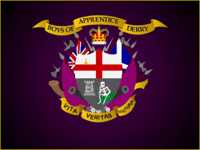 "History of the Siege of Londonderry 1689" Cecil Milligan 1951 lists
the 13 as: Henry Campsie, William Crookshanks, Robert Sherrard,
Daniel Sherrard, Alexander Irwin, James Steward, Robert Morison,
Alexander Cunningham, Samuel Hunt, James Spike, John Coningham,
William Cairnes and Samuel Harvy.
"History of the Siege of Londonderry 1689" Cecil Milligan 1951 lists
the 13 as: Henry Campsie, William Crookshanks, Robert Sherrard,
Daniel Sherrard, Alexander Irwin, James Steward, Robert Morison,
Alexander Cunningham, Samuel Hunt, James Spike, John Coningham,
William Cairnes and Samuel Harvy.
The Apprentice Boys of Derry
1170-1691: From Strongbow to the establishment of Protestant ascendancy
Strongbow The lasting involvement of mainland Britain in Ireland begins in 1170 when the forces of the Anglo-Norman Earl of Pembroke, known as Strongbow, land in County Wexford to help the Irish king of Leinster against a rival king.
The following year, Strongbow becomes King of Leinster. King Henry II arrives with a large force to control his vassal and Norman colonisation increases.
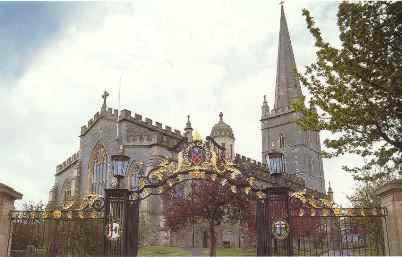 Ulster conquered Ulster is taken by a small force of Anglo-Normans under John de Courcy in 1177.
Ulster conquered Ulster is taken by a small force of Anglo-Normans under John de Courcy in 1177.
Expansion halted Scots invade under Edward Bruce, brother of Robert, in 1315. Anglo-Norman expansion gradually halted and over a long time is reversed.
Beyond the Pale By the late 15th century, the English monarchs' domains are restricted to a small area around Dublin. A line of fortifications, the Pale, is built - the Irish outside are regarded as savages 'beyond the pale'.
Protestant ascendancy In 1541, Henry VIII changes his title from Lord of Ireland to King of Ireland - the first English monarch to claim the whole island.
Elizabeth I - an expansionist era
Accession of Protestant Elizabeth I in 1558 - start of increasing religious differences with Catholic Irish.
English colonisation and reassertion of rights increases, sparking a number of rebellions throughout Elizabeth's reign.
Revolt The greatest of the rebellions, led by Ulsterman Hugh O'Neill, the Earl of Tyrone, reaches its high point with victory over the English at the Yellow Ford in 1598.
Three years later, Spanish troops land at Kinsale in the south. O'Neill marches to support them but is decisively defeated by the English forces under Mountjoy. In 1601, O'Neill surrenders after Elizabeth offers a pardon. She dies, but her successor, James I, fulfils the offer.
Flight of the Earls Faced with growing English influence, O'Neill and another great Ulster lord, Rory O'Donnell, the Earl of Tyrconnell, leave their native land in 1607 aboard a French ship.
Plantation of Ulster Start of the the systematic colonisation in 1609 of Donegal, Tyrone, Derry, Armagh, Cavan and Fermanagh by settlers from England and Scotland.
English civil war Rebellion of native Irish in Ulster in 1641-2, in which 12,000 settlers are killed amid reports of atrocities. Reprisals carried out by Scots army under General Robert Monro.
Owen Roe O'Neill, nephew of Hugh, defeats Monro at the Battle of Benburb in 1646 but fails to exploit his victory.
Cromwell arrives in Drogheda
Cromwellian repression Oliver Cromwell lands in 1649 and brutally suppresses opposition - massacres at Drogheda and Wexford.
Thousands of Catholics are resettled or transported abroad. Catholic land seized - 41% of Antrim, 26% of Down, 34% of Armagh, 38% of Monaghan.
Restoration Charles II restored to English throne in 1660, but land seizures left largely untouched.
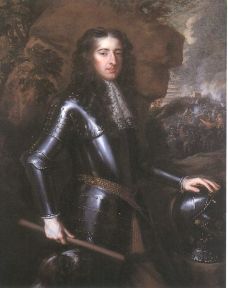 James II - left his crown in England, tried to regain it in Ireland...
Orangemen Three years after his accession, Catholic James II flees in 1688 when William of Orange, later William III, lands in England.
James II - left his crown in England, tried to regain it in Ireland...
Orangemen Three years after his accession, Catholic James II flees in 1688 when William of Orange, later William III, lands in England.
In Derry, 13 apprentice boys close the gates of the city on December 7 in the face of Catholic soldiers.
The following year, James lands in Ireland with French troops and marches on Derry to be met on April 18 with cries of "No surrender!" He lays siege to the city but fails to take it.
...but was defeated at the Boyne
On July 1, 1690, William defeats James at the Battle of the Boyne and James flees back to France.
The supremacy of the Protestants in Ulster is assured by victory at the Battle of Aughrim in 1691.
The Treaty of Limerick in the same year allows 15,000 Irish soldiers to leave to serve France's Louis XIV and promises Catholic toleration.
The Apprentice Boys
The dates in this article are in the old style of dating.
The English adopted a new style calendar in 1752, which added eleven days to its calendar.
On the morning of December 7, 1688, a regiment of Catholic troops crossed Lough Foyle and advanced on Londonderry with the presumed intention of slaughtering all the Protestants within. The town fathers paralyzed by fear, or piously resigned to martyrdom, or stained by treason, were ready to admit the enemy when suddenly a band of thirteen apprentice boys lifted their crimson banners and, with shouts of "No Surrender!" shut the gates in the face of the invaders. Thus began the siege of Londonderry, a frightful ordeal that lasted more than three months before King William's forces broke it.
The Apprentice Boys are still memorialized throughout Protestant Ireland, especially during the summer "marching season." In Londonderry itself, the celebrations are led by the Apprentice Boys of Derry, one of the most powerful Orange lodges, and always include a procession atop the wide city walls to the beat of the Lambeg drums and the booming of Roaring Meg, one of the cannons used to defend the city under siege. Even more than the Battle of the Boyne, it is the salvation of Londonderry by their own hands and their own suffering that warms the blood of Ulster Protestants.
Although the story of the Apprentice Boys is well fixed in legend, it is not quite accurate. The siege, for example, did not begin when the gates were closed, nor were the gates closed for long. When the Lord Lieutenant of Ireland, the Earl of Tyrconnel, learned that his troops had been denied admission to Londonderry, he immediately sent another force which was allowed to enter. The siege did not begin until four months later when King James II demanded the city's surrender. The crimson banners and shouts of "No Surrender!" have no foundation in the original sources and the number of people involved in closing the gates is unknown. Thirteen of the gate-closers were named in the original sources, but they were accompanied by a large crowd.
It is common enough to add imaginative details whenever great events are elevated to the level of legend, but what is most surprising about the story of the Apprentice Boys is that they were not apprentices.
The first version of the event, a letter written two days later by the town authorities, described how "our rabble," "a great number of younger, and some of the meaner sort" acted on their own to the "amazement" of the more responsible citizens. In the next week, the "principal gentlemen" of Derry wrote a second letter and issued an official declaration to explain what had happened; both documents cast blame upon a mob of the "younger and more inconsiderate." In less than a year, however, the rabble receded and a more respectable group took its place. The first history written by an eyewitness, George Walker, published in 1689, referred simply to "the younger sort." The second, written by John Mackenzie, published in 1690, gave the mob a supporting role but had the closing done by a small group of respectable young men, all of whom wore swords, an emblem of gentility in the seventeenth century. Mackenzie named thirteen of the chief participants, prefacing each name with the title "Mr." (for Master), a term never applied to an apprentice boy. Mackenzie's gate-closers were not rabble, but neither were they apprentices.
It is hard to say when the young gentlemen became apprentice boys. There is an account by a contemporary, Thomas Ash, who kept a Circumstantial Journal, in which it is stated that "while we were in this confused hesitation, on the 7th. December, 1688, a few resolute APPRENTICE BOYS determined for us." Ash, however, did not arrive in Londonderry until after the gate closing. If he wrote the statement attributed to him, he was reporting hearsay, but he may not have made the statement at all. It does not actually appear in Ash's journal but in a kind of introduction that was added later, perhaps by the editor who first published the journal a century after the event. If the story of the Apprentice Boys were current by 1689, it is hard to understand why it was not mentioned in the histories written by Walker and Mackenzie and even harder to explain why the Apprentice Boys were still missing a decade later when an epic poem, the Londeriados, was written. The poem describes in vivid detail, and awful verse, every heroic act associated with the siege but says nothing about apprentices. The Apprentice Boys must be an eighteenth-century invention.
Who then closed the gates? Was it the rabble, or respectable young men? The historical context is crucial. In early December 1688, William of Orange had successfully invaded England with the intention of depriving James II of the crown, but James was still in London and still king. Royal officials everywhere had to choose between loyalty to James or defection to William. In Derry, the established government collapsed into indecision and the city was being governed by a few Protestant gentlemen with the general consent of their peers. At the same time, Protestants throughout Ireland were in a panic because of a widespread belief that the Catholics were plotting a massacre for December 9. It was under these circumstances that Tyrconnel, a Catholic, sent a regiment of troops to garrison Londonderry. The troops were sent for the city's defense but there was genuine fear that their mission was more sinister. All contemporary accounts describe an intense debate within the city about allowing the regiment in, and a growing consensus that it should be kept out.
The men governing the city shared that sentiment, but they were already acting on shaky legal grounds and had no desire to implicate themselves further in treasonable activities. They saved themselves by giving their implicit consent that the gates be closed, and then blamed the closing on the always conveniently ungovernable "rabble."
In Mackenzie's opinion, "those who made some figure in the town wished the thing were done, yet none of them thought fit to be themselves active in it." By 1690, when the siege was over and William was King of England, it was time to give credit to the young gentlemen who led the action. What happened in Derry on December 7, 1688 was an orderly urban riot allowed of encouraged by the civil authorities to achieve a public good, and occasional necessity before municipalities acquired more bureaucratic means of governing.
Londonderry was not saved by thirteen apprentices acting in defiance of authority, but that news will hardly cause the Apprentice Boys of Derry to close their lodge, nor will it put an end to the Protestant marches in Northern Ireland. Unlike history, which sleeps in books, legend needs only a nub of fact to move men and women to the emulation of great deeds. Protestants in Ireland rightly venerate the memory of the Apprentice Boys, and Catholics could without shame join parades that honor the bravery of the young Irishmen who acted in December 1688 in defense of their faith. The history that now divides the Irish will at last unite when the Apprentice Boys of Derry live together in a national memory with MacDonagh and MacBride, and Connolly and Pearse.
For a more detailed description, see the Canada-Ulster Heritage Site. Siege of Londonderry
Isle of Lewis - Cradle of the Morrison Clan
Lewis (Leòdhas in Scottish Gaelic) or The Isle of Lewis (Eilean Leòdhais), is the northern part of the largest island of the Western Isles of Scotland or Outer Hebrides (Na h-Eileanan Siar). The southern part of the island is called Harris (Na Hearadh). The two names however refer to the two parts of the same island despite the use of the terms 'Isle of Lewis' and 'Isle of Harris'.
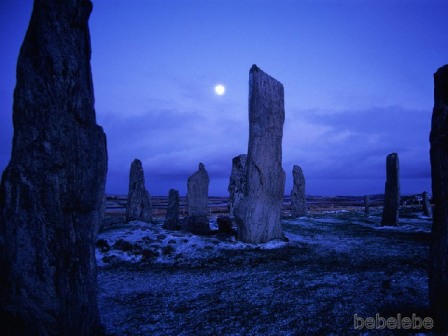 Lewis' main settlement, the only burgh on the Outer Hebrides, is Stornoway (Steòrnabhagh), from which ferries sail to Ullapool on the Scottish mainland. In the 2001 census Lewis had a usually resident population of 16,872. In Scotland's former counties, Lewis was part of Ross-shire (Ross and Cromarty). Historically the island has been a stronghold for the preservation of the Scottish Gaelic language. In recent years however, there has been an upsurge in English speakers migrating into the island, but also being brought up in Lewis. Approximately 99% of the island's population do indeed speak English, with approximately 60% having some understanding of Gaelic. The island's accent and patter is a direct result of hybridisation incorporating the 2 languages. The Lewis accent is indeed not typical of a Scottish accent. Indeed, when native Gaelic speakers speak English, they are often mistaken for being Irish, Welsh and even American by anyone not familiar with the Highland/Gael twang.
Lewis' main settlement, the only burgh on the Outer Hebrides, is Stornoway (Steòrnabhagh), from which ferries sail to Ullapool on the Scottish mainland. In the 2001 census Lewis had a usually resident population of 16,872. In Scotland's former counties, Lewis was part of Ross-shire (Ross and Cromarty). Historically the island has been a stronghold for the preservation of the Scottish Gaelic language. In recent years however, there has been an upsurge in English speakers migrating into the island, but also being brought up in Lewis. Approximately 99% of the island's population do indeed speak English, with approximately 60% having some understanding of Gaelic. The island's accent and patter is a direct result of hybridisation incorporating the 2 languages. The Lewis accent is indeed not typical of a Scottish accent. Indeed, when native Gaelic speakers speak English, they are often mistaken for being Irish, Welsh and even American by anyone not familiar with the Highland/Gael twang.
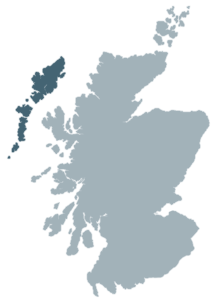 The island's settlements are on or near the coasts or sea lochs, being particularly concentrated on the north east coast. The interior of the island is a large area of moorland from which peat was traditionally cut as fuel, although this practice has become rarer. The southern part of the island, adjoining Harris, is more mountainous with inland lochs. The island of Bernera (Great Bernera) in the district of Uig is linked to the mainland of Lewis by a bridge opened in 1953.
The island's settlements are on or near the coasts or sea lochs, being particularly concentrated on the north east coast. The interior of the island is a large area of moorland from which peat was traditionally cut as fuel, although this practice has become rarer. The southern part of the island, adjoining Harris, is more mountainous with inland lochs. The island of Bernera (Great Bernera) in the district of Uig is linked to the mainland of Lewis by a bridge opened in 1953.
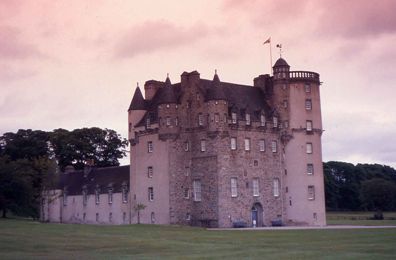 The main industries are fishing, tourism, crafts (including the manufacture of Harris tweed), and crofting. Religion is important in Lewis, with much of the population belonging to the Free Church and Church of Scotland (both Presbyterian in tradition). The Sabbath is generally observed with most shops and licensed premises closed on that day, although there is a scheduled air service to mainland Scotland.
The main industries are fishing, tourism, crafts (including the manufacture of Harris tweed), and crofting. Religion is important in Lewis, with much of the population belonging to the Free Church and Church of Scotland (both Presbyterian in tradition). The Sabbath is generally observed with most shops and licensed premises closed on that day, although there is a scheduled air service to mainland Scotland.
Attractions on the island include the Callanish standing stones, the Clach an Truiseil monolith, the thirteenth century Teampull Mholuaidh church, the Butt of Lewis cliffs and lighthouse and the broch at Dun Carloway. The Lewis chessmen were found on the island in 1831.
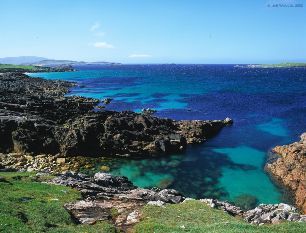 Most of the place names in Lewis and Harris come from Old Norse. The name Lewis is the English spelling of the Gaelic Leòdhas which comes from the Old Norse Ljóðhús, as Lewis is named in medieval Norwegian maps of the island. Ljóðhús translates from Old Norse to English as Home of the Poet (Ljóð = Poet, hús = house). The 12th century ruler of the Island, Leod, taking his name from the Norse word for Poet.
Most of the place names in Lewis and Harris come from Old Norse. The name Lewis is the English spelling of the Gaelic Leòdhas which comes from the Old Norse Ljóðhús, as Lewis is named in medieval Norwegian maps of the island. Ljóðhús translates from Old Norse to English as Home of the Poet (Ljóð = Poet, hús = house). The 12th century ruler of the Island, Leod, taking his name from the Norse word for Poet.
In 1919 the Isle of Lewis suffered a terrible blow with the sinking of the Iolaire, when at the close of the First World War the Admiralty yacht HMY Iolaire, sank within sight of Stornoway's harbour, killing over 200 naval reservists from the island who were returning home after the war.
Norse Origins and King Olaf
History of the Clan Morrison The Norse origin of the Morrison clan is Olaf the Black, who married Lauon and had a son Gillimorrie. This happened about 1214. The son Gillimorrie married a heiress of the Pabbay Castle located to the south of the Isle of Lewis. From this marriage came the two branches of the Clan Morrison. The Morrisons of Harris with the stronghold at Pabbay Castle, and the Morrisons of Lewis with its stronghold at Dun Eistein on the northern tip of the Isle of Lewis.
The Norse origin of the Morrison clan is Olaf the Black, who married Lauon and had a son Gillimorrie. This happened about 1214. The son Gillimorrie married a heiress of the Pabbay Castle located to the south of the Isle of Lewis. From this marriage came the two branches of the Clan Morrison. The Morrisons of Harris with the stronghold at Pabbay Castle, and the Morrisons of Lewis with its stronghold at Dun Eistein on the northern tip of the Isle of Lewis.
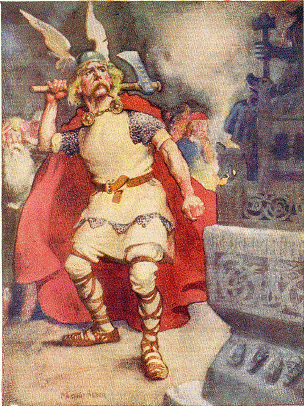 The Morrisons of Pabbay have been traced to living descendants of this day, of which Dr. Iain Morrison has been appointed Chief of the Clan in 1965.
The Morrisons of Pabbay have been traced to living descendants of this day, of which Dr. Iain Morrison has been appointed Chief of the Clan in 1965.The Morrisons of Lewis met their fate around 1616 when their leaders were slain by the rival clan the Macleods. See the following for a legendary rendition of this event.
Battle for Dun Eistein
SEPTS
These are other names most associated with the Morrison Clan. Includes Brieve, MacBrieve, and Gilmore. The Gaelic form of Morrison is Mac-gille-Mhoire, which means son of the Devotee of St. Mary.
The war cry of the Clan are "Dun Uisdean" (Hugh's Castle), and Teaglach Phabbay (Family of Pabbay).
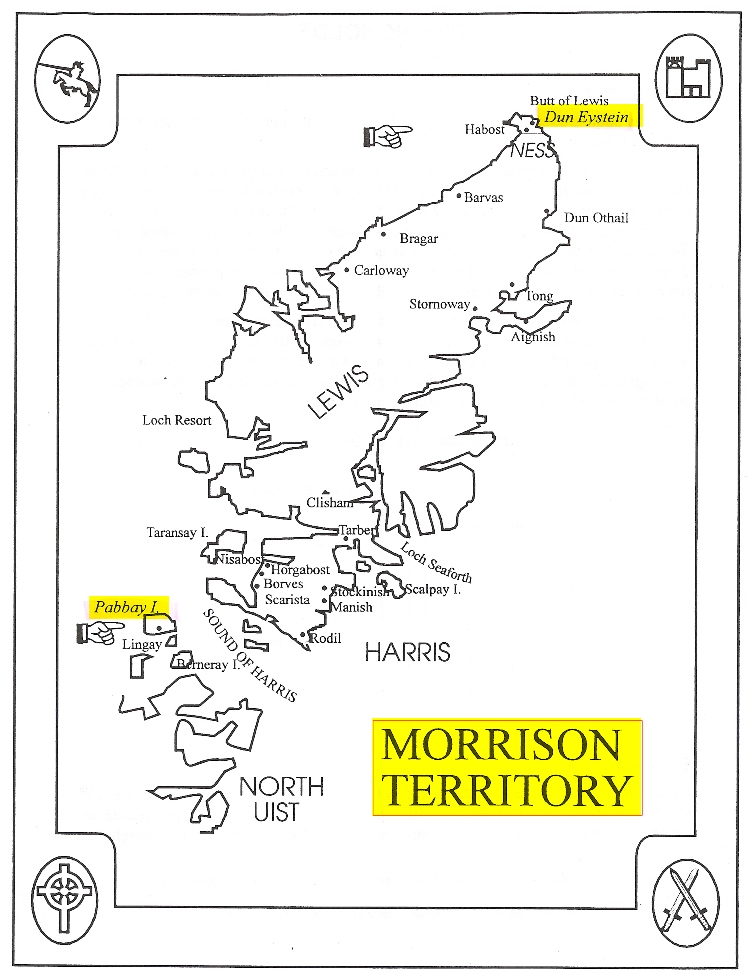
From Charlemagne to Morrison
To view the family tree from Charlemagne to Robert Morrison follow the link.Royalty Morrison Tree
There is no doubt that the Morrisons descend from Governor Thomas Dudley (1576 -1653) of Massachussetts. There is a clear trail from the wife of John Keith Morrison - Charlotte Brown Reed to John Woodbridge who married Mercy Dudley - daughter of the Governor.

However, there has been much debate among historians and some genealogists concerning descent of the Massachusetts Dudleys from the famous Barons Dudley of England. Suffice it to say that Rev. Samuel Dudley, oldest son of Thomas, claimed such descent during his lifetime and apparently was not challenged. Furthermore, Thomas Dudley was accustomed to using the arms (seal) of the Barons Dudley to seal legal documents bearing his signature.
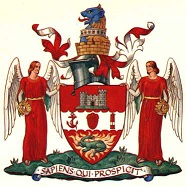 In fact his will, written with his own hand, was sealed with the Dudley arms, indicating that he was descended from the Sutton-Dudleys of Dudley Castle. It was a serious offense under English law to use arms under false pretenses.
In fact his will, written with his own hand, was sealed with the Dudley arms, indicating that he was descended from the Sutton-Dudleys of Dudley Castle. It was a serious offense under English law to use arms under false pretenses.
So as no one has showed up at my door to challenge my descent from this family, we stand by our claim (however little riches it may bring) to be descended from English Royalty.
Tracing 30 plus generations from Charlotte, we come to William the Conqueror. This includes King Henry I and King Henry III. Then it gets interesting.
Around 950 AD we come to Conan the first. Take your pick...
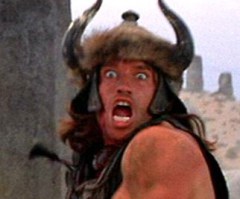

And back further still we come to Charlemagne...
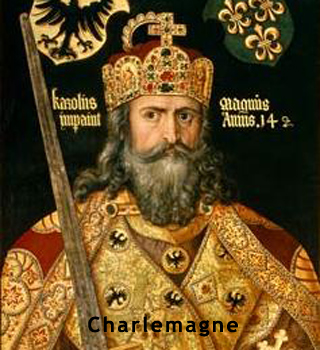
And finally to a member of the Roman Senate.

The Mayflower and Francis Cooke
Francis Cooke SocietyThe Morrisons of Maine are descended from Francis Cooke through the marriage to Mary (Polly) Keith to Robert Morrison, who moved from Middleboro, MA to Maine around the beginning of the 19th century.
To view the family tree from Francis Cooke to Robert Morrison follow the link.
Mayflower Morrison Tree
The ancestry of Francis Cooke is not known. Several ficticious ancestries have been presented, some clearly hoaxes (one can be found in "New Light on the Pilgrim Story", chapter 6. For a discussion of why this is a hoax, see English Ancestry and Homes of the Pilgrim Fathers, by Charles Banks.
 There is conflicting evidence about the birth of Francis Cooke. A note scribbled in Bradford's Journal says Francis Cooke died above the age of 80, meaning he was born before 1583. However, in August 1643, he was in a list of men of Plymouth between the age of 16 and 60 allowed to bear arms. This means he was born after 1583. Also, he was married in Leyden in 1603, so he probably would have been at least 21 at the time. This means a birth before 1583. The fact that all these records seem to conflict suggests that Francis Cook was probably born in 1583.
There is conflicting evidence about the birth of Francis Cooke. A note scribbled in Bradford's Journal says Francis Cooke died above the age of 80, meaning he was born before 1583. However, in August 1643, he was in a list of men of Plymouth between the age of 16 and 60 allowed to bear arms. This means he was born after 1583. Also, he was married in Leyden in 1603, so he probably would have been at least 21 at the time. This means a birth before 1583. The fact that all these records seem to conflict suggests that Francis Cook was probably born in 1583.
Charles Banks mentions a Francis Cooke baptized on 6 April 1572, in Biddenden, Kent, England, son of Thomas. However, this person is about ten years too old for the Francis of the Mayflower. Cooke had been living in Holland about eight years before the arrival of John Robinson and the rest of the Pilgrims. His wife Hester was from Canterbury, England, so perhaps that is where he is from as well. Francis is described as a "Woolcomber from England" in Dutch records dating back as early as 25 April 1603.
 Francis' wife Hester Mahieu was the daughter of Jaques and Jenne Mahieu, French Waloon refuges that had fled to Canterbury, England where Hester was born about 1584. When in Leyden, Holland, from 1603 until the arrival of the Pilgrims, Francis and Hester were members of the French Waloon church. However, in 1606 Francis and his wife left for a trip to Norwich, and they returned in 1607 to have their son baptized in the Church, and in 1608 they rejoined communion with the Walloon Church in Leyden. Sometime between 1611 and 1618, the Cookes switched and began communion with the Pilgrims' Separatist church in Leyden.
Francis' wife Hester Mahieu was the daughter of Jaques and Jenne Mahieu, French Waloon refuges that had fled to Canterbury, England where Hester was born about 1584. When in Leyden, Holland, from 1603 until the arrival of the Pilgrims, Francis and Hester were members of the French Waloon church. However, in 1606 Francis and his wife left for a trip to Norwich, and they returned in 1607 to have their son baptized in the Church, and in 1608 they rejoined communion with the Walloon Church in Leyden. Sometime between 1611 and 1618, the Cookes switched and began communion with the Pilgrims' Separatist church in Leyden.
In 1620, Francis and son John embarked on the Mayflower, leaving behind his wife and younger children (who would come later when the Colony was more settled).
Will of Francis Cooke
BIOGRAPHICAL SUMMARY:
William Bradford recorded his list of passengers that came over in the Mayflower: "Francis Cooke and his son John, but his wife and other children came afterwards". Later in 1651, he writes "Francis Cooke is still living, a very old man, and hath seen his children's children have children. After his wife came over with other of his children; he hath three still living by her, all married and have five children, so their increase is eight. And his son John which came over with him is married, and hath four children living."
Francis and Hester (Mahieu) Cooke had lived in Leyden as early as 1603, about five years before the Pilgrims fled there from England. In 1606, they left Leyden to live at Norwich, England where they joined a French Walloon church; however, they did not stay long in England--probably because of religious persecution--and by 1607 were back in Leyden as members of the French Walloon church there.
Scotland Roots and the Clans
Clan Morrison Society of North AmericaThis section is all about Scottish. From the clans to bagpipes, and a little history scattered about.
The website of the Clan Morrison Society is your source of history as it traces our origins back 800 years ago when the Norse settled on the Isle of Lewis off of Scotland.
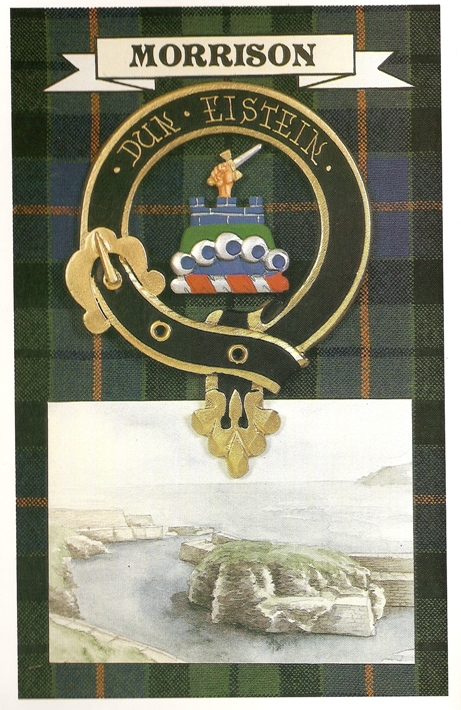
The book at the left is called "Your Clan Heritage: Clan Morrison". This can be viewed below. Please be patient as 16 pages will be loaded. No more than 30 seconds.The tartan depicted on the front of this book is wrong. See below.
Clan Morrison Heritage
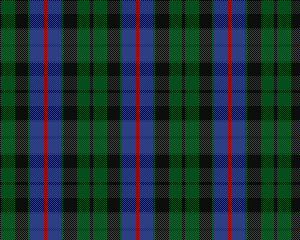 Society: - GREEN (1909). The green Society Tartan is a variant of the MacKay sett with a red stripe. In the absence of an identifiable Morrison Tartan, the Society selected a MacKay sett and added a red stripe. The selection was based on the Morrison ties with the MacKays. Ay Mac Hormaid (Morrison) fell in love with, and married, the daughter of the Bishop of Caithness. Her dowry was the whole of Durness on the mainland, and 60 Morrison families relocated there in the 1600's.
Society: - GREEN (1909). The green Society Tartan is a variant of the MacKay sett with a red stripe. In the absence of an identifiable Morrison Tartan, the Society selected a MacKay sett and added a red stripe. The selection was based on the Morrison ties with the MacKays. Ay Mac Hormaid (Morrison) fell in love with, and married, the daughter of the Bishop of Caithness. Her dowry was the whole of Durness on the mainland, and 60 Morrison families relocated there in the 1600's.
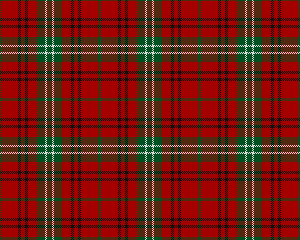 Clan: - RED (Lyon Court Book #21 , 03 January 1968). In the 1930's, workers demolishing a "Black House" on the island of Lewis, discovered an old bible wrapped in a scarlet tartan. An enclosed note, dated 1745, identified the tartan as belonging to the Morrisons. It was officially recognized as the Morrison Tartan by the Lord Lyon on January 3, 1968. It was first worn again at the 1964 Clan Gathering.
Clan: - RED (Lyon Court Book #21 , 03 January 1968). In the 1930's, workers demolishing a "Black House" on the island of Lewis, discovered an old bible wrapped in a scarlet tartan. An enclosed note, dated 1745, identified the tartan as belonging to the Morrisons. It was officially recognized as the Morrison Tartan by the Lord Lyon on January 3, 1968. It was first worn again at the 1964 Clan Gathering.
Good web sites to visit for Scotland and Scottish related events
The Internet Guide to ScotlandThis website has links to Links, maps, books, clan and genealogy FAQs.
Scottish Highland Games
This website has the schedules for all Scottish events throughout the US.
Scotlands People
Another website for researching genealogy in Scotland.
